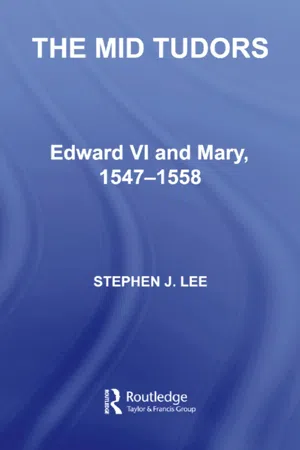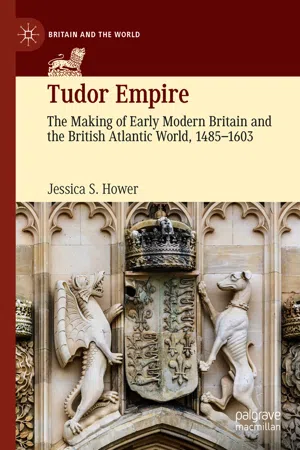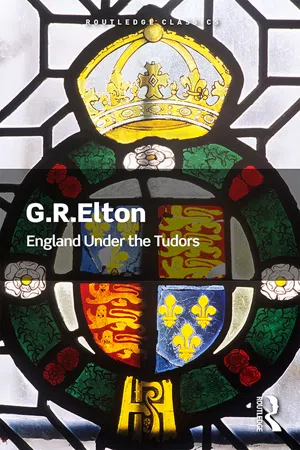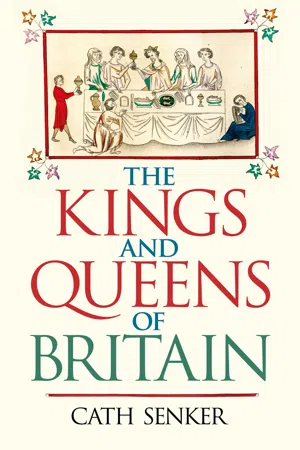History
Mid-Tudor Crisis
The "Mid-Tudor Crisis" refers to a period of political, social, and economic instability in England during the mid-16th century, encompassing the reigns of Henry VIII's children, Edward VI, Mary I, and Elizabeth I. This era was marked by religious turmoil, economic challenges, and political uncertainty, including rebellions and power struggles. The crisis ultimately shaped the trajectory of the English Reformation and the consolidation of royal authority.
Written by Perlego with AI-assistance
Related key terms
5 Key excerpts on "Mid-Tudor Crisis"
- eBook - ePub
The Mid Tudors
Edward VI and Mary, 1547–1558
- Stephen J. Lee(Author)
- 2006(Publication Date)
- Routledge(Publisher)
7 A Mid-Tudor Crisis?
BACKGROUND
The term ‘crisis’ has been devalued through over-liberal use. The most common understanding of ‘crisis’ is a low point in a period of development, marked by serious problems which might possibly lead to revolution or to some other form of political or social disintegration. But there is another element that also needs to be kept in mind. More specifically, a ‘crisis’ is an identifiable point within a sequence of events where the outcome hangs in the balance – and could go one way or the other. It can be compared with the crisis stage within a fever, which is followed by either recovery or death. For ‘crisis’ to be used properly, the first definition should really be associated with the second. If ‘crisis’ is to be applied to the whole period between 1547 and 1558, the reigns of Edward VI and Mary would need to be seen as more or less constantly on a knife-edge, with the whole structure of government, economy and society threatened with collapse or some drastic change. Only then could we accept the feasibility of an overall ‘crisis’.Analysis 1 argues that the reigns of Edward VI and Mary saw a number of individual crises – specific developments where the outcome was, or could have been, dangerous. Analysis 2 examines the historiography of the debate on whether or not there was a more general – or ‘mid-Tudor’ – crisis threatening the collapse of the Tudor system altogether.ANALYSIS 1: HOW SERIOUS WERE THE CRISES OCCURRING IN ENGLAND BETWEEN 1547 AND 1558?
Any period of 11 years encompassing two whole reigns, plus the end and beginning of two others, will be bound to experience turbulent events, and with them a strong element of unpredictability. The reigns of Edward VI and Mary had more than their fair share of these – political, religious, economic and social. But how serious were they within the broader perspective of Tudor history? - eBook - ePub
Tudor Empire
The Making of Early Modern Britain and the British Atlantic World, 1485-1603
- Jessica S. Hower(Author)
- 2020(Publication Date)
- Palgrave Macmillan(Publisher)
Americas as well as on plantation as the best mode of rule and on religious dissidents as a means to settle new territories; the ascent of Habsburgs as the Tudors’ primary rival; the advance of a protestant British vision of nation and empire in direct contrast to Catholic Iberian alternatives; and the rise and increasing standardization of new sorts of joint ventures—like crown-patented trading companies—that merged public and private resources and personnel.Somerset’s fall and the end of war with Scotland encouraged a group of rising scholar-statesmen practiced in early Tudor administration and empire to apply the discourses developed and experiences gained in Tournai , the break with Rome, and the Rough Wooings to move already-extant enterprise in Ireland and the Americas forward. Several years later, Edward’s death and Mary’s coronation did not bring about a clean rupture from what had come before. Rather, the new queen’s gender, familial ties, and faith led to a shift: the court followed a trail blazed by Henry VII and used marriage, precedent, consolidation at home, and experimental enterprise abroad to secure the throne for its female king and propagate her imperial crown. For the emerging Tudor empire, Mary’s Spanish union was particularly salient. It brought a flood of Habsburg personnel, goods, expertise, and texts into England, where they lent new inspiration and impetus—both positive and negative—to adventure and quickened national and xenophobic feelings. Upon Mary’s death, Elizabeth’s accession fused with the loss of Calais , anti-Spanish and anti-Catholic sentiment, and the storm of European sectarian upheaval to raise the queen’s profile as the Atlantic World’s protestant protector, turn Ireland and the Americas into perceived silver bullets to stem British decline and global Iberian hegemony, and draw Tudor subjects, Catholic and protestant, away from home. From 1547 to 1558, five monarchs and two regents ruled England, Wales , Ireland, parts of France and the New World; and yet, as Eden - eBook - ePub
- G.R. Elton(Author)
- 2018(Publication Date)
- Routledge(Publisher)
VIIIThe Crisis Of the Tudors, 1540–58
1. The Last Years of Henry VIIIThomas Cromwell’s fall marked something of a period in Tudor history. By depriving himself of his outstanding servant, Henry VIII destroyed the efficiency and the purpose of his government. For eighteen years—first under an ailing old man, then under a child, and finally under a woman—Tudor rule was tested to the utmost. That it survived at all was a tribute to the work of Henry VII, to the depth of king-worship and obedience to established authority which Henry VIII’s terrifying personality had riveted upon an England anxious to avoid disorder, and also to the administrative reforms of Thomas Cromwell which up to a point made continued government possible even when the crown failed to play its part. But while Tudor rule survived, to be resuscitated by Elizabeth and her more than competent ministers, it underwent such vicissitudes in those years—was so rarely animated by a steady or intelligent purpose—that the total achievement would fill barely a page. The years served a purpose: passions played themselves out in the clashing of extremes which, having had their turn, retained the less strength to trouble the government of Elizabeth; but such an argument savours of the ancient heresy that all things work to the best of all possible ends and that success crowns the work. It also under-estimates the degree to which the free play of passions, mostly religious, under Edward VI and Mary encouraged the growth of divisions which beset England in the second half of the century. It is impossible to say what would have happened but for the relaxation of good government between 1540 and 1558. The keynote of those eighteen years of somewhat purposeless turmoil is found in the development of the doctrinal changes which Henry VIII’s constitutional revolution had set in motion despite his will. It is a story of the conflict of two extremes in religion alternately getting the upper hand, with a complicating admixture of international troubles and diversified by a gigantic economic crisis. This last deserves, and shall have, a chapter to itself. - eBook - ePub
- Cath Senker(Author)
- 2021(Publication Date)
- Arcturus(Publisher)
The Tudors 1485–1603T he ferocious rivalry of the Houses of York and Lancaster was over, to be replaced by a new civil conflict over religion. Like a butterfly effect, the desire of Henry VIII for a divorce prompted far-reaching changes: the English Reformation and decades of struggle between Catholics and Protestants. The religious wrangling did not prevent economic development though. An era of European exploration began in Tudor times, bringing riches from trade and exploitation, and new ideas; the monarchy benefited greatly from this period of prosperity. The Tudors did not rule alone – they had to recognize the importance of Parliament in running the country and relied on talented public servants. Yet the most dynamic king and queen, Henry VIII and Elizabeth I, had a substantial personal impact on politics, economics and society.TUDOR MONARCHS
Henry VII (1485–1509) Henry VIII (1509–47) Edward VI (1547–53) Mary I (1553–58) Elizabeth I (1558–1603)HENRY VII (1485–1509)
Henry VII ended the War of the Roses, marrying Elizabeth of York to unite the houses of Lancaster and York and founding the Tudor dynasty. To stamp his authority on the land after three decades of civil war, he ruled harshly. Was his assertion of royal authority necessary to stabilize the country or did his tyrannical tendencies have a destabilizing effect? Historians today give a mixed verdict on the success of Henry’s rule.Securing stability
Henry’s throne certainly remained insecure, and there were several Yorkist plots against him. One pretender was Perkin Warbeck. The son of a boatman from Tournai, Belgium, Warbeck was persuaded in 1491 to pretend that he was Richard, Duke of York (the younger of the princes in the Tower), who had somehow escaped from the Tower of London. By 1493, the king had uncovered the plot and brought treason trials against Warbeck’s associates. When Warbeck landed with a force of 300 men in Kent in 1495, he and his followers were captured. The Englishmen among them were hanged for treason, while the pretender himself was eventually executed in 1499. Henry’s message to his enemies was clear. - eBook - ePub
- Cath Senker(Author)
- 2020(Publication Date)
- Arcturus(Publisher)
The Tudors 1485–1603The ferocious rivalry of the Houses of York and Lancaster was over, to be replaced by a new civil conflict over religion. Like a butterfly effect, the desire of Henry VIII for a divorce prompted far reaching changes: the English Reformation and decades of struggle between Catholics and Protestants. The religious wrangling did not prevent economic development though. An era of European exploration began in Tudor times, bringing riches from trade and exploitation, and new ideas; the monarchy benefited greatly from this period of prosperity. The Tudors did not rule alone – they had to recognize the importance of Parliament in running the country and relied on talented public servants. Yet the most dynamic king and queen, Henry VIII and Elizabeth I, had a substantial personal impact on politics, economics and society.HENRY VII(1485–1509)Henry VII ended the War of the Roses, marrying Elizabeth of York to unite the houses of Lancaster and York and founding the Tudor dynasty. To stamp his authority on the land after three decades of civil war, he ruled harshly. Was his assertion of royal authority necessary to stabilize the country or did his tyrannical tendencies have a destabilizing effect? Historians today give a mixed verdict on the success of Henry’s rule.A contemporary portrait of Henry VII.SECURING STABILITY
Henry’s throne certainly remained insecure, and there were several Yorkist plots against him. One pretender was Perkin Warbeck. The son of a boatman from Tournai, Belgium, Warbeck was persuaded in 1491 to pretend that he was Richard, Duke of York (the younger of the princes in the Tower), who had somehow escaped from the Tower of London. By 1493, the king had uncovered the plot and brought treason trials against Warbeck’s associates. When Warbeck landed with a force of 300 men in Kent in 1495, he and his followers were captured. The Englishmen among them were hanged for treason, while the pretender himself was eventually executed in 1499. Henry’s message to his enemies was clear.
Index pages curate the most relevant extracts from our library of academic textbooks. They’ve been created using an in-house natural language model (NLM), each adding context and meaning to key research topics.




